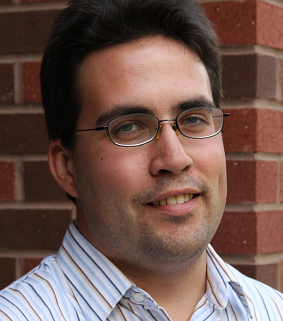Track: Optics
Undergrad: Southern Oregon University, Ashland, OR - Physics
Internship: nLIGHT
Current Job Title: Field Application Engineer at Timbercon
Background
Oddly enough, I started out as a fine art major. I had an aptitude and was planning to become an art teacher – high school, community college, something like that. I took classes like Drawing, Painting, Fundamentals, and Art History. At some point I decided to switch to physics. I don’t remember why exactly, but I do remember feeling that if I continued down the path of getting an art degree, I probably wouldn’t finish. It’s the lack of structure that goes along with being an art major; they don’t want to stifle creativity.
Physics was much more structured, and that appealed to me. Before I knew it, I was president of the physics club. People are always asking me when they find out, “how can you switch between art and physics? How can your brain think like both?” For me, the same talents that made me a good artist make me a good physicist: creativity, good spatial reasoning, and the patience to see something through. Most people don’t realize that fine art and paintings begin as unrecognizable sketches. I do realize that art and science ultimately aren’t the same. I like that science, by design, is irrefutable. It’s the search for the ultimate truth (with physical limitations of course).
My Experience with the Master's Internship Program
I choose the Master’s Industrial Internship Program because it really is a bridge to high-tech industry. After undergrad I was ready to stop living as a college student. I wanted a career that would put me on a financial path that would allow me to have a family and a house. This program offered that. The first three months over the summer were hard. We were given so much work it seemed impossible to finish all of it; but in retrospect that is what prepared us the most. Working in an industrial setting you learn to adapt while moving forward. You won’t know everything; you have to evolve. Mistakes will be made, and you’ll have to figure out how to deal with them in real time while still making progress. It sounds stressful; it is stressful, but so worth it when you look back and see all you’ve accomplished. The internship didn’t feel like an internship. Right from the get-go I was thrown into the world of manufacturing engineering. At first my responsibilities were minimal and I made a lot of mistakes. Everyone was really nice and I did have some amnesty as an intern. Gradually I made fewer mistakes and was given more responsibility. When my internship ended I barely noticed (besides being paid much better). I still went to work the next day on the projects I was currently working on.
Process/Manufacturing Engineer at nLight
Working in manufacturing, my job is to keep a production line going. I am responsible for the yields of a variety of products nLight manufactures. My physics background helps me overcome the technical challenges of high technology manufacturing, and my on-the-job training helps me monitor production though statistical analysis and organizational philosophy. I learned terms like Six Sigma and Lean Manufacturing. During my internship I oversaw existing manufacturing lines, but afterward I got to help develop a new product and create a new manufacturing line. I’ve seen not only how to make a new product, but how to make it ten times in a row with the expectation of making it thousands of times in a row.
The Master's Program and my career path
The program introduced me to the company that gave me my career start. Now I have a path to achieve the things I want in life.

